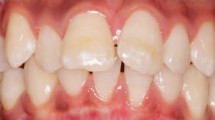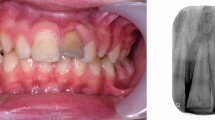Abstract
White enamel lesions are a common presentation to the general dentist and aesthetic concerns are the most frequent presenting problem. Aetiology may be multifactorial and management of such lesions is heavily dependent on the cause. In the paediatric patient, differentiating white lesions caused by caries, fluorosis and genetic and developmental disorders is key to offering optimal long-term treatment outcomes. Early intervention allows for carefully planned management of less common disorders. Many of these disorders exist along a spectrum, and white lesions offer a useful clue to prompt intervention and referral to the relevant specialists. This article overviews common white lesions of the teeth and outlines the hierarchy of management options available.
Key points
-
Early enamel caries may present as white lesions; it is important to treat these successfully to avoid progression and the need for invasive treatment.
-
White lesions may be of chronological aetiology such as dental fluorosis and molar-incisor hypomineralisation.
-
Genetic disorders such as amelogenesis imperfecta may also present as white enamel lesions.
This is a preview of subscription content, access via your institution
Access options
Subscribe to this journal
Receive 24 print issues and online access
$259.00 per year
only $10.79 per issue
Buy this article
- Purchase on Springer Link
- Instant access to full article PDF
Prices may be subject to local taxes which are calculated during checkout








Similar content being viewed by others
References
Deveci C, Çınar Ç, Tirali R E. Management of White Spot Lesions. In Zühre Akarslan (ed) Dental Caries - Diagnosis, Prevention and Management. London: InTechOpen, 2018.
Hasmun N, Lawson J, Vettore M V, Elcock C, Zaitoun H, Rodd H. Change in oral health-related quality of life following minimally invasive aesthetic treatment for children with molar incisor hypomineralisation: A prospective study. Dent J 2018; 6: 61.
Hasmun N, Vettore M V, Lawson J A, Elcock C, Zaitoun H, Rodd H D. Determinants of children's oral health-related quality of life following aesthetic treatment of enamel opacities. J Dent 2020; 98: 103372.
Duggal M, Cameron A, Toumba J. Paediatric Dentistry at a Glance. Hoboken: Wiley-Blackwell, 2012.
Ismail A I, Pitts N B, Tellez M et al. The International Caries Classification and Management System (ICCMSTM) An Example of a Caries Management Pathway. BMC Oral Health 2015; 15 Suppl 1(Suppl 1): S9.
Drummond B K, Meldrum A M, Boyd D. Influence of dental care on children's oral health and wellbeing. Br Dent J 2013; 214: E27.
Guerrieri A, Gaucher C, Bonte E, Lasfargues J J. Minimal intervention dentistry: part 4. Detection and diagnosis of initial caries lesions. Br Dent J 2012; 213: 551-557.
Zandoná A F, Zero D T. Diagnostic tools for early caries detection. J Am Dent Assoc 2006; 137: 1675-1684.
Madhumitha M, Prabhu V R, Senthil R. Diagnostic methods for early detection of dental caries - A review. Int J Paedod Rehabil 2016; 1: 29-36.
Walmsley A D, Walsh T F, Lumley P J et al. Caries and other reasons for restoring teeth. In Walmsley A D, Walsh T F, Lumley P J et al (eds) Restorative Dentistry. 2nd ed. pp 57-72. London: Churchill Livingstone, 2007.
Darcey J. Saving Smiles: Improving outcomes following dental trauma. 2018. Available at https://www.dental-referrals.org/wp-content/uploads/2017/08/Saving-Smiles-V8.pdf (accessed July 2020).
Diab M, elBadrawy H E. Intrusion injuries of primary incisors. Part II: Sequelae affecting the intruded primary incisors. Quintessence Int (Berl) 2000; 31: 335-341.
Sherwood I A. Fluorosis varied treatment options. J Conserv Dent 2010; 13: 47-53.
Iheozor-Ejiofor Z, Worthington H V, Walsh T et al. Water fluoridation for the prevention of dental caries. Cochrane Database Syst Rev 2015; DOI: 10.1002/14651858.CD010856.pub2.
Ayoob S, Gupta A K. Fluoride in drinking water: A review on the status and stress effects. Crit Rev Environ Sci Technol 2006; 36: 433-487.
Wong M C, Glenny A-M, Tsang B W, Lo E C, Worthington H V, Marinho V C. Topical fluoride as a cause of dental fluorosis in children. Cochrane Database Syst Rev 2010; DOI: 10.1002/14651858.CD007693.pub2.
Public Health England. Water Fluoridation: Health monitoring report for England 2018. 2018. Available online at https://www.gov.uk/government/publications/water-fluoridation-health-monitoring-report-for-england-2018 (accessed July 2020).
Whelton H, Crowley E, O'Mullane D et al. North South survey of children's oral health in Ireland 2002. Dublin: Department of Health and Children, 2006.
Fulton A, Amlani M, Parekh S. Oral manifestations of vitamin D deficiency in children Vitamin D. Br Dent J 2020; 228: 515-518.
Davit-Béal T, Gabay J, Antoniolli P, Masle-Farquhar J, Wolikow M. Dental complications of rickets in early childhood: Case report on 2 young girls. Paediatrics 2014; DOI: 10.1542/peds.2013-0733.
Ladhani S, Srinivasan L, Buchanan C, Allgrove J. Presentation of vitamin D deficiency. Arch Dis Child 2004; 89: 781-784.
Cashman K D, Dowling K G, Škrabáková Z et al. Vitamin D deficiency in Europe: Pandemic? Am J Clin Nutr 2016; 103: 1033-1044.
National Health Service. Rickets and osteomalacia - Symptoms. 2018. Available at https://www.nhs.uk/conditions/rickets-and-osteomalacia/symptoms/ (accessed July 2020).
Koch G, Poulsen S, Espelid I, Haubek D. Paediatric Dentistry: A Clinical Approach. 3rd ed. Hoboken: Wiley-Blackwell, 2016.
Slootweg P. Dental Pathology - A Practical Introduction. 2nd ed. Berlin: Springer-Verlag Berlin Heidelberg, 2013.
Gadhia K, McDonald S, Arkutu N, Malik K. Amelogenesis imperfecta: An introduction. Br Dent J 2012; 212: 377-379.
Welbury R, Duggal M, Hosey M. Paediatric Dentistry. 5th ed. Oxford: Oxford University Press, 2018.
Almuallem Z, Busuttil-Naudi A. Molar incisor hypomineralisation (MIH) - an overview. Br Dent J 2018; 225: 601-609.
Alaluusua S. Aetiology of Molar-Incisor Hypomineralisation: A systematic review. Eur Arch Paediatr Dent 2010; 11: 53-58.
Walmsley A D, Walsh T F, Lumley P J et al. Restoration of teeth (simple restorations) and preventative dentistry. In Walmsley A D, Walsh T F, Lumley P J et al (eds) Restorative Dentistry. 2nd ed.pp 73-87. London: Churchill Livingstone, 2007.
Lygidakis N A, Wong F, Jälevik B, Vierrou A M, Alaluusua S, Espelid I. Best Clinical Practice Guidance for clinicians dealing with children presenting with Molar-Incisor-Hypomineralisation (MIH): An EAPD Policy Document. Eur Arch Paediatr Dent 2010; 11: 75-81.
Heasman P. Master Dentistry: Volume 2: Restorative Dentistry, Paediatric Dentistry and Orthodontics. 3rd ed. London: Elsevier Health Sciences UK, 2013.
Public Health England. Delivering better oral health: an evidence-based toolkit for prevention - Third Edition. 2017. Available online at https://www.gov.uk/government/publications/delivering-better-oral-health-an-evidence-based-toolkit-for-prevention (accessed July 2020).
Raphael S, Blinkhorn A. Is there a place for Tooth Mousse in the prevention and treatment of early dental caries? A systematic review. BMC Oral Health 2015; 15: 113.
Li J, Xie X, Wang Y et al. Long-term remineralizing effect of casein phosphopeptide-amorphous calcium phosphate (CPP-ACP) on early caries lesions in vivo: A systematic review. J Dent 2014; 42: 769-777.
Denis M, Atlan A, Vennat E, Tirlet G, Attal J-P, Attal White J-P. White defects on enamel: Diagnosis and anatomopathology: Two essential factors for proper treatment (part 1). Int Orthod 2013; 11: 139-165.
Greenwall-Cohen J, Greenwall L H. The single discoloured tooth: vital and non-vital bleaching techniques. Br Dent J 2019; 226: 839-849.
Kwon S R, Wertz P W. Review of the Mechanism of Tooth Whitening. J Esthet Restor Dent 2015; 27: 240-257.
Wray A, Welbury R. Treatment of intrinsic discoloration in permanent anterior teeth in children and adolescents. Int J Paediatr Dent 2001; 11: 309-315.
Bartlett D, Brunton P. Aesthetic Dentistry (QuintEssentials of Dental Practice Book 19). 1st ed. London: Quintessence Publishing Co., 2005.
General Dental Council. Position statement on tooth whitening. 2016. Available at https://www.gdc-uk.org/docs/default-source/what-is-the-legal-position/tooth-whitening-position-statement.pdf (accessed July 2020).
Wong F S L, Winter G B. Effectiveness of microabrasion technique for improvement of dental aesthetics. Br Dent J 2002; 193: 155-158.
Sundfeld R H, Sundfeld-Neto D, Machado L S, Franco L M, Fagundes T C, Briso A L F. Microabrasion in tooth enamel discoloration defects: Three cases with long-term follow-ups. J Appl Oral Sci 2014; 22: 347-354.
Anand V, Arumugam S B, Manoharan V, Kumar S A, Methippara J J. Is Resin Infiltration a Microinvasive Approach to White Lesions of Calcified Tooth Structures?: A Systemic Review. Int J Clin Paediatr Dent 2019; 12: 53-58.
Greenwall L. White lesion eradication using resin infiltration. Int Dent Afr Ed 2013; 3: 54-62.
Wiechmann D. Lingual Orthodontics (Part 3): Intraoral Sandblasting and Indirect Bonding. J Orofac Orthop 2000; 61: 280-291.
Borges A B, Caneppele T M F, Masterson D, Maia L C. Is resin infiltration an effective esthetic treatment for enamel development defects and white spot lesions? A systematic review. J Dent 2017; 56: 11-18.
Chu S J, Devigus A, Paravina R D, Mieleszko AJ. Fundamentals of Colour: Shade Matching and Communication in Esthetic Dentistry. 2nd ed. Chicago: Quintessence Publishing Co. Inc., 2011.
Vanini L. Light and colour in anterior composite restorations. Pract Periodontics Aesthet Dent 1996; 8: 673-682.
Duarte S. QDT Quintessence of Dental Technology. 2nd ed. Chicago: Quintessence Publishing Co. Inc., 2014.
Fahl N. Step-by-Step Approaches for Anterior Direct Restorative Challenges Mastering Composite Artistry to Create Anterior Masterpieces - Part 2. J Cosmet Dent 2011; 26: 42-55.
Magne P. Composite resins and bonded porcelain: the postamalgam era? J Calif Dent Assoc 2006; 34: 135-147.
Magne P, Belser U. Understanding the intact tooth and the biomimetic principle. In Magne P, Belser U (eds) Bonded Porcelain Restorations in the Anterior Dentition: A Biomimetic Approach. pp 23-55. Chicago: Quintessence Publishing Co., 2002.
Acknowledgements
With thanks to the young patients and their parents/guardians for allowing us to reproduce their clinical photographs.
Author information
Authors and Affiliations
Contributions
All authors (Jai Jandu, Nikita Dzyuba and Siobhan Barry) have contributed equally to the work.
Corresponding author
Ethics declarations
The authors declare no conflict of interests and received no funding for this article.
Rights and permissions
About this article
Cite this article
Jandu, J., Dzyuba, N. & Barry, S. White enamel lesions in children: considering caries, chronological and congenital causes and their consequent care. Br Dent J 230, 523–527 (2021). https://doi.org/10.1038/s41415-021-2838-x
Received:
Accepted:
Published:
Issue Date:
DOI: https://doi.org/10.1038/s41415-021-2838-x
This article is cited by
-
The remineralization effect of GERM CLEAN on early human enamel caries lesions in vitro
Scientific Reports (2023)



